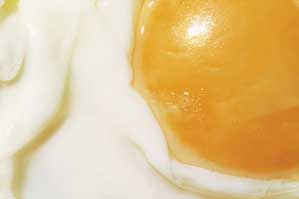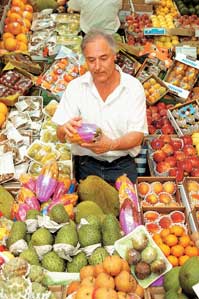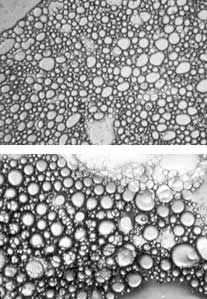 MIGUEL BOYAYANHervé This is French, lives on the outskirts of Paris and knows many things that topnotch chefs are not even aware of. Egg-based dishes are one of his specialties. In fact, his vocation to work with food products was aroused 27 years ago, when he decided not to follow the recipe of a blue cheese soufflé that he had come across in a womens’ magazine – he added all the eggs at once. But the soufflé was a flop. The following week, he tried again, but this time he added the eggs one by one. The soufflé was better, but still not perfect. In his third attempt, he finally followed the recipe word by word. He added two eggs at a time and – voilá! – the soufflé was perfect. So This asked himself why the way in which eggs were added in the recipe made such a huge difference to the end result. Ever since, he has been studying this and other small mysteries in food recipes, some of which have as their main – or secondary ingredients – the best delicacy that a hen can provide to humanity, with the exception of the hen itself, of course. His discoveries include, for example, a way of “uncooking” an egg (a pinch of reducing agent sodium boro hydrate, NaBH4, and three hours of waiting deal with this eccentric task very well) and the ideal temperature to heat an egg so that the egg white is as smooth as possible without hardening the egg yolk (a number of tests showed him that 65°C is the best alternative).
MIGUEL BOYAYANHervé This is French, lives on the outskirts of Paris and knows many things that topnotch chefs are not even aware of. Egg-based dishes are one of his specialties. In fact, his vocation to work with food products was aroused 27 years ago, when he decided not to follow the recipe of a blue cheese soufflé that he had come across in a womens’ magazine – he added all the eggs at once. But the soufflé was a flop. The following week, he tried again, but this time he added the eggs one by one. The soufflé was better, but still not perfect. In his third attempt, he finally followed the recipe word by word. He added two eggs at a time and – voilá! – the soufflé was perfect. So This asked himself why the way in which eggs were added in the recipe made such a huge difference to the end result. Ever since, he has been studying this and other small mysteries in food recipes, some of which have as their main – or secondary ingredients – the best delicacy that a hen can provide to humanity, with the exception of the hen itself, of course. His discoveries include, for example, a way of “uncooking” an egg (a pinch of reducing agent sodium boro hydrate, NaBH4, and three hours of waiting deal with this eccentric task very well) and the ideal temperature to heat an egg so that the egg white is as smooth as possible without hardening the egg yolk (a number of tests showed him that 65°C is the best alternative).
The first mistake made by anyone watching This at work is to identify him as a modern, contemporary chef, the kind who whips up a warm ice cream out of parmesan cheese or uses liquid nitrogen on tiny portions of food that look like something from the distant future. Though he admires these creative culinary professionals and influences them with his studies, he is not a chef. This has a physics and chemistry degree, and does not work in any Parisian restaurant. He punches a time clock at the laboratory of the Institute Nationale de la Recherche Agronomique (Inra) and at the prestigious Collège de France, where, at the invitation of Chemistry Nobel Prize laureate Jean-Marie Lehn, he has taught courses and conducted experiments since 1995 in the field of molecular gastronomy, in which he is internationally renowned. This worked alongside Hungarian physicist Nicholas Kurti, whose professional career was entirely spent at Oxford University and who passed away in 1998. This is renowned as the founder of molecular gastronomy, an expression coined by the two physicists in the late eighties.
The second mistake is to misunderstand the meaning of this sub-topic of the overall topic, namely food sciences. “Molecular gastronomy is the study of restaurant-made and home-made culinary transformations and the phenomena connected to the act of eating”, explains the physicist- chemist, who was in Brazil last October to give lectures and launch three special Scientific American issues, in Portuguese, dedicated to his specialty. “I’m not interested in trying to understand industrial cookery.”
Not everybody agrees with the expression molecular gastronomy to describe the kind of research studies conducted by This. Some scientists argue that, unlike molecular biologists, the French physicist-chemist does not study the interaction among individual molecules when dishes are being prepared. They claim that This is only concerned with the chemical elements in food products.

EDUARDO CESARThis during his visit to the Mercado Municipal food market in São Paulo: Recipes from cookbooks should be in museumsEDUARDO CESAR
Stars and soufflé
Despite the controversy, This and his followers explain that their work does not consist in investigating, in isolation, the components of fruit, vegetables or meat, as food scientists do, but rather to scrutinize, with scientific methodology, the phenomena that take place during the preparation of a recipe, to try to understand the role of each ingredient – and what makes up a given ingredient – and to decipher the importance (or not) of the procedures involved in making a given dish. In short, they research the “how to” of cookery, of the food that people carefully prepare, often complying with allegedly indispensable precepts, which may be technical, dictated by local culture, or mere superstition.
In this search for explanations for what goes on inside pots and pans or ovens, they ask themselves questions that other scientists might think silly, but that are actually eternal doubts voiced by both amateur and professional cooks. Is it true that, as popular belief has it in France, mayonnaise made by menstruating women goes bad? That cutting off a pig’s head right after taking it out of the oven really keeps the pig’s skin crisp and crunchy?
Answers to these sorts of questions – respectively no and yes to the two questions above – are what drives the work of this new frontier of research. “It is sad to know that we know more about the temperature of the stars than that of a soufflé”, said Kurti, at a celebrated lecture filmed by the BBC in 1969, during what one might call the “prehistory” of molecular gastronomy. At the time, in addition to literally verifying that the temperature inside a soufflé ranged from 20 to 70°C, the Hungarian physicist caused a sensation when he concocted a dessert in a new home appliance, the microwave oven.
For kitchen scientists, the art of transforming plants or animals into food products did not evolve and is tied to recipes that often call for unnecessary ingredients or demand useless procedures or processes whose functions are unknown. “It’s madness, but we still cook as though we were in the Middle Ages”, said This. During his visit to São Paulo, he found time to visit the Mercado Municipal produce market; he was delighted with the colors and flavors of Brazil’s various regions. “We’re overly tied to tradition and we follow ancient cookbooks that should be in museums.”
Ingrid Schmidt-Hebbel, coordinator of the Gastronomy Technology course at the Senac college, also voiced her opinion on the subject. “Nothing really new happened in the field of gastronomy in the twentieth century”, said Ingrid, who specializes in food biochemistry. “The use of new equipment run on electricity simply made it easier to perform manual tasks, but the procedures remained essentially unchanged.”
By broadening knowledge about cooking procedures, the French physicist and chemist believes he can help mankind to eat better in the twenty-first century. He does not believe that man’s daily meals will be similar to the dehydrated food of astronauts, but he enjoys encouraging contemporary chefs to use specific molecules instead of traditional ingredients to achieve better results. For example, instead of squeezing the classic lemon juice on vegetables to prevent them from darkening, why not simply use ascorbic acid, also known as Vitamin C? After all, it is the acid in the citrus juice that has the protective effect. Many classic cooks still frown on the ideas of molecular gastronomy. But some chefs, such as Ferran Adrià, the Catalan of the famed El Bulli restaurant, have become spokespersons for this new cooking style which resorts, albeit partially and specifically, to the experiments and discoveries of This and other scientists.
From the scientific standpoint, each part of a dish can be illustrated as a dispersed or colloidal system, a homogeneous mixture in which a substance divides itself into tiny particles and spreads through a second substance. This is not a very appetizing way of looking at a pudding or a lasagna, but it helps one understand the inner architecture of a recipe. From this point of view, three states of matter can be involved in a dish (solids, liquids and gases). These states can be dispersed, introduced one to the other or overlap. Rarely is any cooking preparation totally solid, which would make it difficult to swallow, or liquid (in this case, it would be drink and not food). This even developed a type of notation with letters and a few words to represent the types of ingredients and procedures that are required to make a dish.

Photos from press publicityTwo images in the inside of a mixture of water, gelatin and oil: before (on the left) and after the preparation has turned into a gelPhotos from press publicity
Foolproof Recipes
Perhaps the most interesting contribution in the analysis of culinary preparations is the formulation of an equation that tries to quantify a recipe’s robustness. A robust recipe is one that only has a small chance of going wrong. The formula takes into account a number of parameters, such as the mass of the ingredients, the time and the temperature employed at each step of the recipe and the other instructions for making the dish. After working out the calculations and gathering information on more than 25 thousand recipes in cookbooks, This concluded that the robust nature of a recipe is inversely proportional to the recipe’s volume of instructions. In other words, simpler recipes tend to work better. The general rule seems to make sense for the preparation of grilled carrots, soufflés, boiled eggs, mayonnaise and roast meat. “Soups and sauces are the exception, as it is hard for them to go wrong, but there are many variations in their recipes because of their enormous culinary importance”, says This.
Because it is one of the most basic elements of any kitchen, and is the leading character in countless sweet or savoury recipes, the egg is the star in This’s studies. Why does the perfect egg have to be cooked or fried at a temperature of approximately 65°C, at a lower temperature than is standard for other foods? At this temperature, the egg white coagulates very delicately, because only one of its proteins – ovotransferine – changes its characteristics. The effects on the egg yolk are even less. The egg yolk remains almost raw and – like the egg white – one of the proteins – gamma-livetine – hardens. To reach this conclusion, the researcher cooked countless eggs in his lab, varying the temperature slightly at each attempt and observing the effects on the egg’s elements. Thus, he established the coagulation temperature of each of the proteins in the egg white and in the yolk. “What is really important is the temperature at which the egg is cooked and not how long it is cooked”, says This.
In another line of research, also about egg whites and yolks, the Frenchman showed that eggs can sometimes be eliminated from certain recipes. He created a whipped chocolate cream whose cream emulsion demands no egg whites (the recipe can be found at the Pesquisa Fapesp website). The well known chef Pierre Gagnaire, who creates a new recipe every month based on This’s studies, included the novelty in his menu a few years ago. The chocolate can be replaced by another ingredient – one can make whipped cheese cream, whipped butter cream or whipped foie gras. It might seem strange, but perhaps food in the future will bring together formats and flavors that human beings are not used to.
Republish